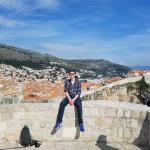Support
During my semester abroad in Vienna, Austria, I was fortunate enough to spend my spring break in Croatia and Montenegro. The trip was made possible through a generous travel enrichment grant from the Weaver/Nicolais Family International Travel Endowment Fund. For 10 days, I traveled down the coastline of Croatia and into Montenegro. The goal of my trip was to visit the cities once controlled by the Venetian empire, and a city that avoided total Venetian rule. Beyond just Venetian influences, this region once belonged to the Roman Empire, the Habsburg Empire, and a variety of other cultures, thereby allowing me to experience how the present is a literal blend of cultures from the past. I was accompanied by one of my close friends from home for the journey.
We woke up at 4am in Vienna and boarded a bus bound for Pula, Croatia. At the Slovenia-Croatia border, we were held up for hours due to a change in security protocol, resulting in us missing our bus connection in Zagreb. However, a wonderful Croat named Ann, also headed to Pula, argued with the bus company in Zagreb and got us free tickets to Pula later in the day.
Once we finally got to Pula, we went to bed in order to make the most of the next day. We woke up early and immediately started to explore the small city. Pula is home to a beautiful Roman amphitheater that rivals the majesty of the coliseum. We toured the amphitheater in the morning, before heading to a museum located in an old Venetian fort atop a hill. We ate dinner by the ocean and had a typical Dalmatian dish (Dalmatian is the name of the coast and the region) which was a delicious chicken dish covered in a tasty sauce. The day ended with us watching a beautiful sunset on the rocky coast.
At the crack of dawn, we took a small plane to Zadar. During the 20-minute flight, I watched the sun peek above the horizon and splash the coast and accompanying islands with pinkish hues. This beautiful dawn was a portend of things to come. We stayed in an Airbnb located in the old town of Zadar. The old town is a rectangular island connected to mainland by two bridges. We walked along the Venetian walls that enclosed the old town, before heading to the Romanesque 9th century Saint Donatus Church, one of the oldest Churches in Croatia. The church was located in the old Roman central square (Forum), which had ruins from thousands of years ago. We later watched the sunset next to the Sea Organ, a series of steps designed so that when the waves crash up against them, the sounds of an organ reverberate around the area. It was serene hearing the rhythmic lapping of waves accompanied by the mysterious, melodic sound of an organ, all while the sun set the sky ablaze in red and yellow as it bowed out behind the ocean.
The next day, we took a bus along the coast to Split. We spent 2 days in the city, which was home to Diocletian’s Palace, one of the best preserved Roman structures in the world. We toured the 4th century Palace and took a day trip to Trogir, a nearby costal town that once belonged to the Venetian empire and still contains the lovely St. Lawrence Cathedral. After that, we had originally planned on kayaking around the bay on a guided tour, but it was canceled the week before. Instead, the next day we went to the verdant Plitvice Lakes National Park, home to the largest waterfall in Croatia. Later we capped off the day by eating dinner in front of Diocletian’s Palace, on the promenade made by Napoleon’s troops in the 19th century.
After Split, we took a bus to Dubrovnik. Dubrovnik is the most famous city in Croatia and regarded as one of the most beautiful in Europe. The old city is entirely walled off by massive stone walls that border the ocean on three sides. Contained within is a medieval town, replete with churches and buildings capped in orange terracotta tiles, which glistened in the sun. The television show Game of Thrones is filmed here (scenes located in King’s Landing). We walked along the walls and toured the main church. Towering above the old town is a fortress upon a cliff. My friend and I headed there next and were able to see a commanding view of Dubrovnik.
The next day, we went on guided tour of Kotor, Montenegro. Similar to Dubrovnik, Kotor is an old medieval city that has towering walls. However, Kotor still has a moat and is tucked beneath a mountain! The walls extend up the mountain to a fortress. We hiked up the walls and within an hour sat atop the fortress surveying the breath-taking bay of Kotor. The bay is surrounded by lush, green mountains and the water is azure and sparkling. I’m not sure I have seen a more beautiful sight. Our tour guide wanted to show us Budva, a nearby resort town, so we sadly left Kotor and continued onwards. In Budva, we ate a delicious meal at a restaurant on the water. Upon learning we were Americans, our waiter took out his phone and showed us a picture of Senator John McCain eating at our exact table the week prior. Unfortunately, our trip to Montenegro was only a day-trip, so we had to leave the amazing country, and return to Croatia.
The following morning, I said goodbye to my friend and boarded a plane back to Vienna. During the 10 days, I saw countless historic building, ranging from stunningly preserved Roman Palaces to Venetian forts-turned-history-museums. I was able to witness the cultural diffusion that took place between empires and regions and how the Mediterranean is an area packed with history. The history I learned in class came alive through the generosity of the Weaver/Nicolais Family International Travel Endowment Fund.
